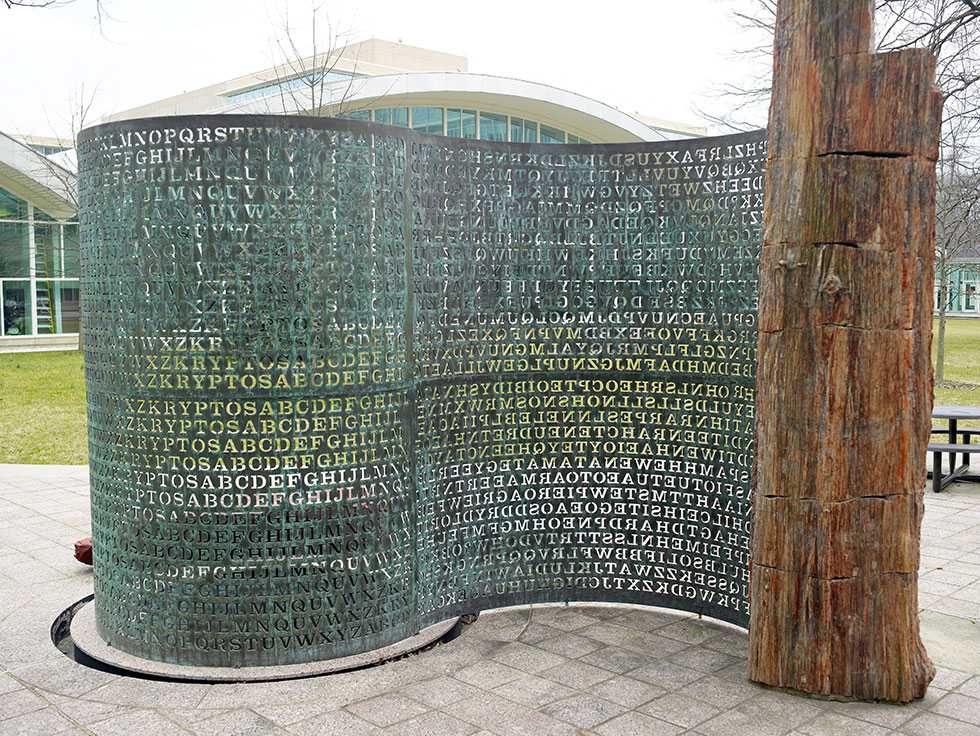House of Games - David Mamet (1987)
Can You Crack the Uncrackable Code in Kryptos, the CIA’s Work of Public Art?
The hands-on part fell well within Sanborn’s purview. But a Masters in sculpture from Pratt Institute does not automatically confer cryptography bonafides, so Sanborn enlisted Edward Scheidt, the retired chairman of the CIA’s Cryptographic Center, for a crash course in late 20th-century coding systems.
Sanborn sampled various coding methods for the finished piece, wanting the act of deciphering to feel like “peeling layers off an onion.”
That onion has been partially peeled for years.
Deciphering three of its four panels is a pelt shared by computer scientist and former president of the American Cryptogram Association, James Gillogly, and CIA analyst David Stein.
Is it a comment on the cultural, socio-economic or political context in which it was created?
Or is the act of creating it the artist’s most salient point?
Are multiple interpretations possible?
Artist Jim Sanborn’s massive sculpture Kryptos may inspire various reactions in its viewers, but there’s definitely a single correct interpretation.
But 78-year-old Sanborn isn’t saying what…
He wants someone else to identify it.
Kryptos’ main mystery — more like “a riddle wrapped in a mystery inside an enigma” to quote Winston Churchill — was hand cut into an S‑shaped copper screen using jigsaws.
Sometimes the title will offer a clue, or the artist will shed some light in an interview.
Is it a comment on the cultural, socio-economic or political context in which it was created?
Or is the act of creating it the artist’s most salient point?
Are multiple interpretations possible?
Artist Jim Sanborn’s massive sculpture Kryptos may inspire various reactions in its viewers, but there’s definitely a single correct interpretation.
But 78-year-old Sanborn isn’t saying what…
He wants someone else to identify it.
Kryptos’ main mystery — more like “a riddle wrapped in a mystery inside an enigma” to quote Winston Churchill — was hand cut into an S‑shaped copper screen using jigsaws.

The Music of the Pelican State Rises Up From Somewhere Deep
Dr Terror deals the Death card: how tarot was turned into an occult obsession
What do you do when anything goes? Duchamp’s Telegram
Nicolas Poussin: The Rape of the Sabine Women, 1637-1638
Phill Niblock
We Are Ukrainians: Learning From the 2023 Kyiv Biennial
Ripping Ivy
Punk zine
January 6 United States Capitol attack
Anthology Of Contemporary Post Industrial Music - Various Artists (2023)
Matchday 1: Kenneth Kaunda - Maher Mezahi
HARVARD SQUARE LITERARY MAP: A Walk-in-Progress
"The Harvard Square Lit Map is an invitation to explore the literary history of Cambridge, Massachusetts, and to experience 'the presence of a plurality of times.' The Lit Map is a collaborative atlas created by Lynn Sayers and Chris Lenney (of Lamont Library), in conjunction with the Woodberry Poetry Room. We also wish to thank the countless poets, scholars, and members of the general public, who contributed immensely to our knowledge of historic venues and creative locales: their names are listed below the map-in-progress. The map represents only a small portion of the total artistic activity in the vicinity and is in no way indicative of the breadth and depth of what has been created here. It is simply “the mooring of starting out,” as John Ashbery would say, a way for you to begin your literary exploration…. In creating this map, we also wish to acknowledge the Massachusett, Pequot, Wampanoag, and other Indigenous peoples, who have long inhabited this land—with their profound histories, cultures, and voices. Please assist us in expanding our understanding of the area by notifying us of any mistakes we’ve made and by suggesting names and past addresses of writers, communities, and historic literary venues that could be added to the growing list below. This Blog post features only a sample of the sites we hope to include in a larger project in the future. ..."
Dead Internet theory
Wildflowers: The New York Loft Jazz Sessions (1976)
The 2023 High School Yearbook of American Politics
Frozen In Time: This is Darkness playlist – December 2023
Past Lives - Celine Song (2023)
Past Lives review – a must-see story of lost loves, childhood crushes and changing identities. "This heart-meltingly romantic and sad movie from Korean-Canadian dramatist and film-maker Celine Song left me wrung out and empty and weirdly euphoric, as if I’d lived through an 18-month affair in the course of an hour and three-quarters. How extraordinary to think that this is Song’s feature debut. It’s delicate, sophisticated and yet also somehow simple, direct, even verging on the cheesy. Past Lives has been compared to the movies of Richard Linklater, Noah Baumbach and Greta Gerwig; all true, but I also found myself remembering the wrenching final moments of Wong Kar-wai’s In the Mood for Love, with Tony Leung murmuring his pain into a stone hollow in Angkor Wat and – yes – the gooey genius of Dean Friedman’s plaintive 1978 chart hit Lucky Stars. This is a story of lost love and childhood crush, the painful and dangerous access to the past given by digital media; the roads not taken, the lives not led, the futile luxury of regret. ..."
Michigan Supreme Court Decides Trump Can Stay on Ballot
In Campus Protests Over Gaza, Echoes of Outcry Over Vietnam
Smithsonian: What Was the Protest Group Students for a Democratic Society? Five Questions Answered
TIME: How the Weather Underground Failed at Revolution and Still Changed the World

















.jpg)





















